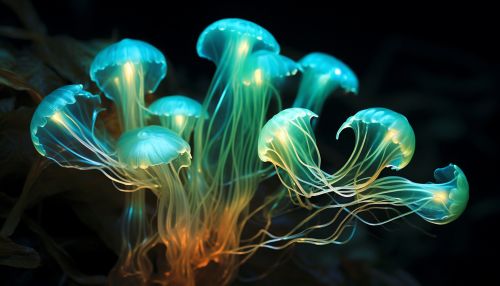The Chemistry of Bioluminescence and Its Applications
Introduction
Bioluminescence is a fascinating natural phenomenon where light is produced by a chemical reaction within a living organism. It is a type of chemiluminescence, which occurs in numerous marine organisms such as bacteria, algae, jellyfish, worms, crustaceans, sea stars, fish, and sharks, as well as in some insects, mushrooms, and bacteria. The chemistry of bioluminescence is a complex process that involves the interaction of various molecules and enzymes. This article delves into the intricate chemistry of bioluminescence and its diverse applications.
Chemistry of Bioluminescence
The chemical reaction that leads to bioluminescence involves at least two unique chemicals: luciferin and either luciferase or a photoprotein. The luciferin reacts with oxygen to create light. The luciferase acts as a catalyst to speed up the reaction, while the photoprotein binds to the luciferin and acts in the presence of certain ions.
Luciferin
Luciferin is a generic term for the light-emitting compound found in organisms that generate bioluminescence. Luciferins are highly diverse, reflecting the variety of organisms that use bioluminescence and the different evolutionary paths they have taken. The chemical structures of luciferins vary between different species, but they all produce light through the process of chemiluminescence.
Luciferase
Luciferase is an enzyme that catalyzes the oxidation of luciferin. Different luciferases catalyze the oxidation of different luciferins, leading to the emission of light of different colors. The color of the light depends on the structure of the luciferin and the nature of the luciferase.
Photoproteins
Photoproteins are a type of protein that emits light upon binding with a particular ion. Unlike luciferases, photoproteins do not require an external source of energy to produce light. Instead, they store energy in a chemically excited state and emit light when triggered by the presence of a specific ion.
Bioluminescence Reaction
The bioluminescence reaction can be summarized as follows: luciferin + oxygen + ATP → oxyluciferin + light + AMP + PPi. This reaction is catalyzed by luciferase. The energy for the reaction comes from the hydrolysis of ATP, which is used to convert luciferin into a high-energy intermediate. This intermediate is then oxidized by oxygen, resulting in the production of light.


Applications of Bioluminescence
Bioluminescence has a wide range of applications, from medical research and diagnostics to environmental monitoring and even lighting and display technologies.
Medical Research and Diagnostics
In medical research and diagnostics, bioluminescence is used as a tool to study cellular processes, track the spread of cancer cells, and monitor gene expression. The use of bioluminescent markers allows researchers to visualize biological processes in real-time, providing valuable insights into the functioning of cells and tissues.
Environmental Monitoring
Bioluminescent organisms can be used as bioindicators to monitor the health of ecosystems. Changes in the patterns of bioluminescence can indicate changes in environmental conditions, such as pollution levels, temperature changes, or the presence of certain chemicals.
Lighting and Display Technologies
Bioluminescence is also being explored as a sustainable and energy-efficient source of light. Bioluminescent organisms or genetically engineered cells could potentially be used to create self-sustaining light sources, reducing our reliance on electricity.
Conclusion
The chemistry of bioluminescence is a complex and fascinating field that has wide-ranging applications. From its role in medical research to its potential use in sustainable lighting technologies, the study of bioluminescence offers exciting possibilities for the future.
